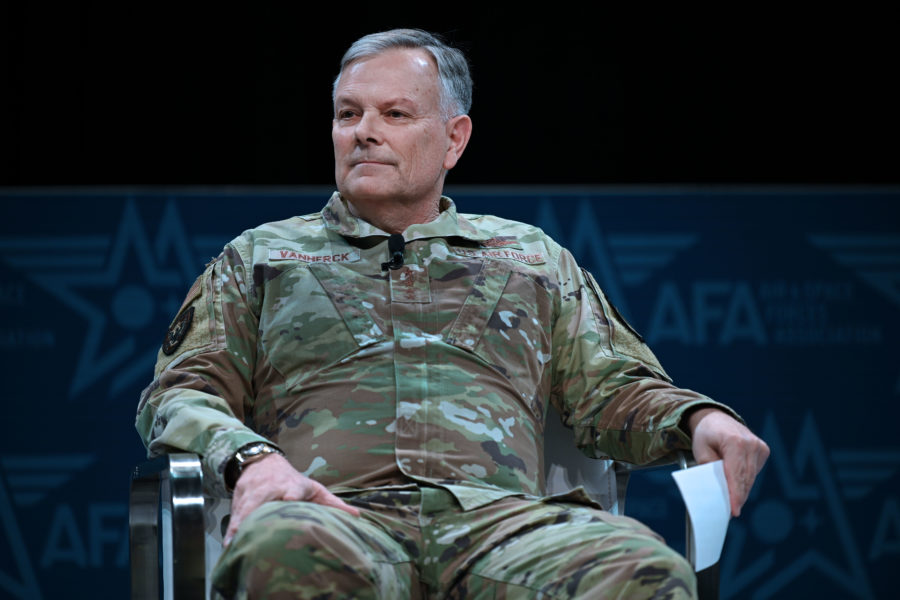AURORA, Colo.—After a Chinese high-altitude spy balloon traversed the United States in late January and early February, much of the public spotlight focused on Gen. Glen D. VanHerck, the head of U.S. Northern Command (NORTHCOM) and the North American Aerospace Defense Command (NORAD).
And the question at the top of most minds: How did this happen?
VanHerck has had to answer tough questions from Congress and from the media about why NORAD could not better track the object.
But for VanHerck, the incident has now become a call to arms. The man in charge of America’s homeland defense is finally in the spotlight as the Pentagon talks of an increasingly assertive China and a Russia that is lashing out against its foes.
“Actually, that high-altitude balloon was a great opportunity for NORAD and United States Northern Command to get some attention that I think we deserved,” VanHerck said during a panel at the AFA Warfare Symposium on March 6.
VanHerck, who has been in his job since 2020, has long clamored for better capabilities to see the threats America faces.
“Domain Awareness: Hey, you can’t deter, you can’t defeat something if you can’t detect it,” VanHerck said, highlighting his top focus for the command.
On top of that, VanHerck said, he also needs “information dominance” in order to provide decision-makers more time to consider their options.
“That’s about getting more time,” VanHerck explained. “The only thing I can’t get the President and the Secretary of Defense enough of is time.”
In the case of the Chinese balloon, it wasn’t displaying “hostile intent,” so VanHerck didn’t have the authority to act right away. Information had to run up the chain of command. President Biden didn’t learn of the balloon’s existence until days after it first entered U.S. airspace on Jan. 28, administration officials have said.
VanHerck himself knew the Chinese balloon program existed since August 2022, he said. The balloons had been detected by the intelligence community in incidents dating back to the Trump administration. The U.S. is now working to exploit the Chinese balloon’s debris for information
“Going forward, we know a lot more now,” VanHerck said.
VanHerck wants to eventually be able to use artificial intelligence and machine learning to improve his threat detection capabilities, alluding to some of the capabilities the Pentagon’s Joint All-Domain Command and Control concept promises. But in VanHerck’s case, he doesn’t want an AI-assisted automated balloon-killing device. When the ultimate backstop to protect the U.S. is its nuclear arsenal, what NORAD needs is information.
“I think the services are focused too much on ‘sensor to shooter,'” VanHerck said. “We need more sensor to decision-maker.”
Added VanHerck: “I think we’ve been too focused on deterrence by punishment and that doesn’t give our most senior leaders many options. What we have to do is give options to our senior leaders to create and fill that space. Those options are what I would say are deterrence by denial.”
Ultimately, the balloon incident was a wake-up call to the whole nation, perhaps for the better, VanHerck said.
The Chinese balloon drew intense scrutiny of NORAD’s mission from the top brass at the Pentagon and the West Wing of the White House. When the U.S. adjusted its radar settings so it would no longer filter out slow-moving objects such as balloons, NORTHCOM ended up shooting down three objects that were likely harmless on President Joe Biden’s orders.
But VanHerck has long pointed out that cruise missiles are the most acute threat to the American homeland, along with ballistic missiles, and Russia has already proven it can launch long-range cruise missiles from inside its own airspace and target another country in its attacks on Ukraine. NORAD’s North Warning System radar network is an antiquated relic of the Cold War that was designed for Soviet bombers. VanHerck has previously warned that Russian air-launched cruise missiles could be a possible threat to the homeland. He also sees an increased risk from ballistic missile submarines in the Atlantic and Pacific.
Meanwhile, NORAD is moving to update the North Warning System and has next-generation missile interceptors coming online—eventually.
“We’re pretty much stuck with what we have in the near term, VanHerck said. “I think the future of homeland defense looks vastly different than it does today. It’s autonomous unmanned platforms that can loiter for long times. That can create domain awareness. We can do kinetic and non-kinetic effectors.”
Whatever the future holds for America’s homeland defense, it will likely be better resourced than in the past.
“It’s great to have that opportunity to tell our story about the challenges we face—the domain awareness challenges we have in the homeland,” VanHerck said. “Magically, the appropriators want to talk to me.”
